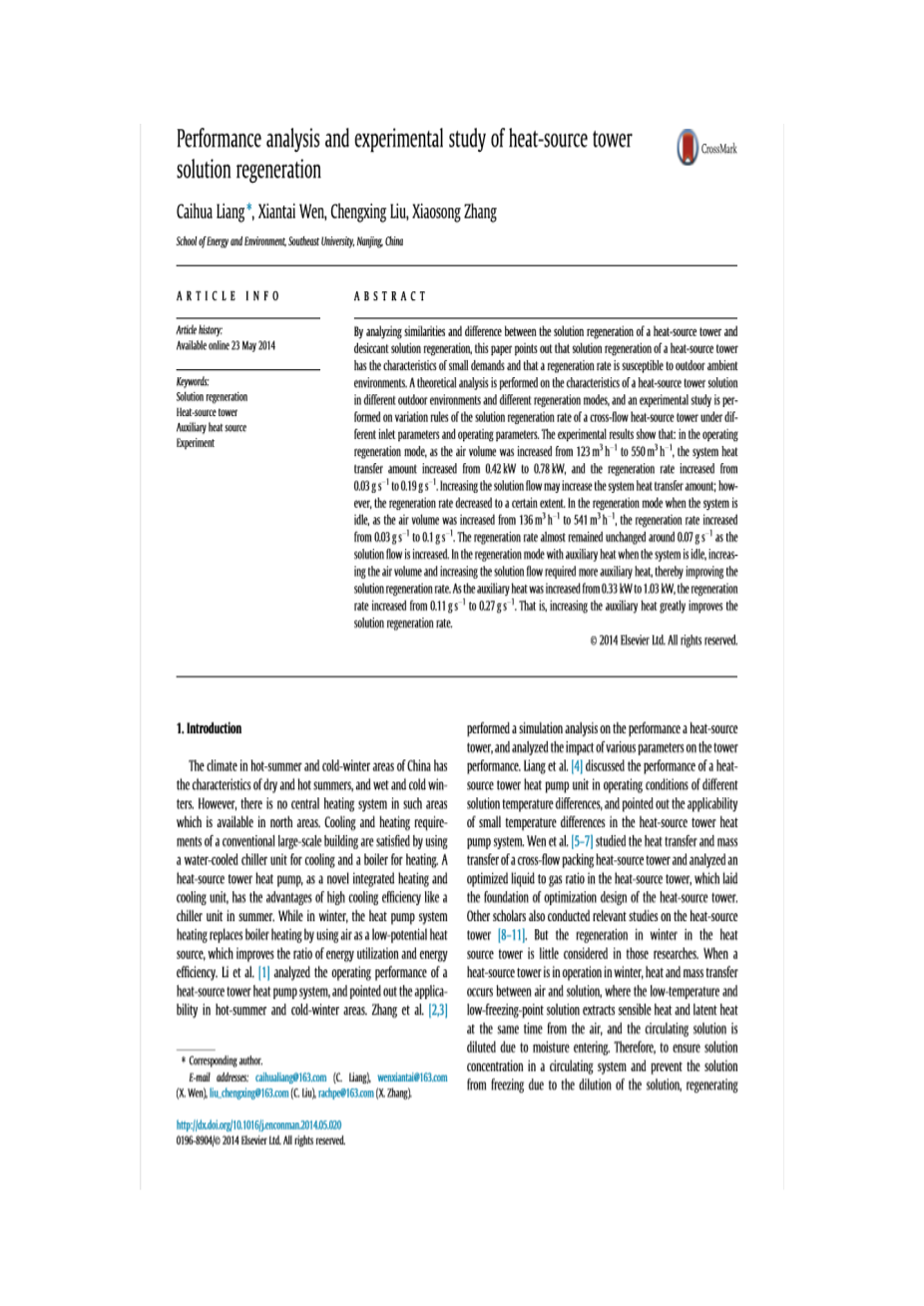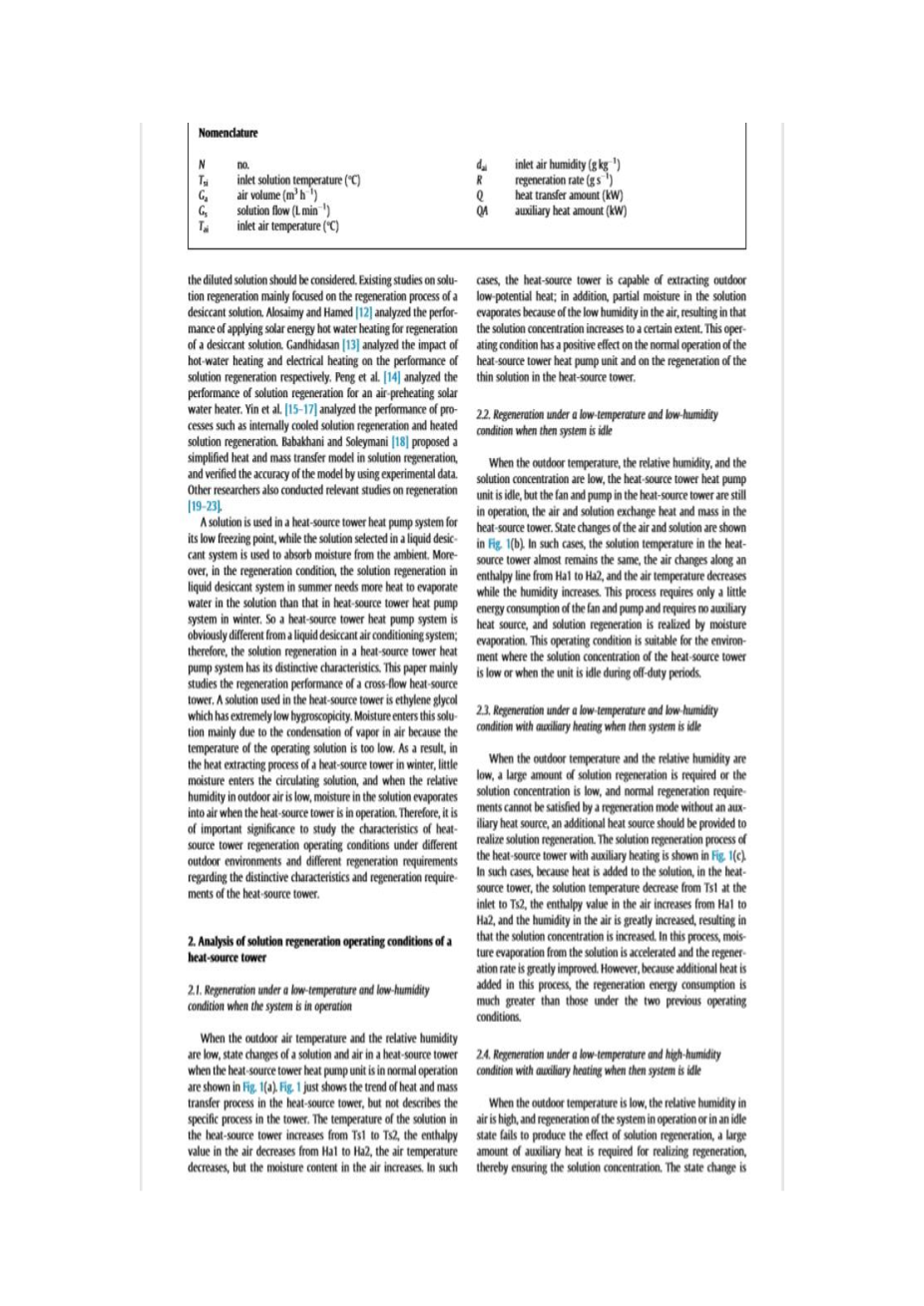

英语原文共 15 页,剩余内容已隐藏,支付完成后下载完整资料
Performance analysis and experimental study of heat-source tower solution regeneration
热源塔溶液再生的性能分析与实验研究
|
Abstract By analyzing similarities and difference between the solution regeneration of a heat-source tower and desiccant solution regeneration, this paper points out that solution regeneration of a heat-source tower has the characteristics of small demands and that a regeneration rate is susceptible to outdoor ambient environments.A theoretical analysis is performed on the characteristics of a heat-source tower solution in different outdoor environments and different regeneration modes, and an experimental study is performed on variation rules of the solution regeneration rate of a cross-flow heat-source tower under different inlet parameters and operating parameters. The experimental results show that: in the operating regeneration mode, as the air volume was increased from 123 m3/ h to 550 m3/ h, the system heat transfer amount increased from 0.42 kW to 0.78 kW, and the regeneration rate increased from 0.03 g /s to 0.19g/s.Increasing the solution flow may increase the system heat transfer amount; the regeneration rate decreased to a certain extent. In the regeneration mode when the system is idle, as the air volume was increased from 136m3/ h to 541 m3/ h, the regeneration rate increased from 0.03 g /s to 0.1g /s . The regeneration rate almost remained unchanged around 0.07g/s as the solution flow is increased. In the regeneration mode with auxiliary heat when the system is idle, increasing the air volume and increasing the solution flow required more auxiliary heat, there by improving the solution regeneration rate. As the auxiliary heat was increased from 0.33 kW to 1.03 kW, the regeneration rate increased from 0.11 g /s to 0.27 g /s . That is, increasing the auxiliary heat greatly improves the solution regeneration rate. 1.Introduction The climate in hot-summer and cold-winter areas of China has the characteristics of dry and hot summers, and wet and coldwinters.However,there is no central heating system in such areas which is available in north areas. Cooling and heating requirements of a conventional large-scale building are satisfied by using a water-cooled chiller unit for cooling and a boiler for heating. A heat-source tower heat pump, as a novel integrated heating and cooling unit, has the advantages of high cooling efficiency like a chiller unit in summer. While in winter, the heat pump system heating replaces boiler heating by using air as a low-potential heat source, which improves the ratio of energy utilization and energy efficiency. Li et al.[1] analyzed the operating performance of a heat-source tower heat pump system, and pointed out the applicability in hot-summer and cold-winter areas. Zhang et al. [2,3] performed a simulation analysis on the performance a heat-source tower, and analyzed the impact of various parameters on the tower performance. Liang et al. [4] discussed the performance of a heatsource tower heat pump unit in operating conditions of different solution temperature differences,and pointed out the applicability of small temperature differences in the heat-source tower heat pump system. Wen et al. [5–7] studied the heat transfer and mass transfer of a cross-flow packing heat-source tower and analyzed an optimized liquid to gas ratio in the heat-source tower, which laid the foundation of optimization design of the heat-source tower. Other scholars also conducted relevant studies on the heat-source tower[8–11]. But the regeneration in winter in theheat source tower is little considered in those researches. When a heat-source tower is in operation in winter, heat and mass transfer occurs between air and solution, where the low-temperature and low-freezing-point solution extracts sensible heat and latent heat at the same time from the air, and the circulating solution is diluted due to moisture entering. Therefore, to ensure solution concentration in a circulating system and prevent the solution from freezing due to the dilution of the solution, regenerating the diluted solution should be considered. Existing studies on solution regeneration mainly focused on the regeneration process of a desiccant solution. Alosaimy and Hamed [12] analyzed the performance of applying solar energy hot water heating for regeneration of a desiccant solution. Gandhidasan [13] analyzed the impact of hot-water heating and electrical heating on the performance of solution regeneration respectively. Peng et al. [14] analyzed the performance of solution regeneration for an air-preheating solar water heater. Yin et al. [15–17] analyzed the performance of processes such as internally cooled solution regeneration and heated solution regeneration. Babakhani and Soleymani [18] proposed a simplified heat and mass transfer model in regeneration, and verified the accuracy of the model by using experimental data. Other researchers also conducted relevant studies on regeneration. A solution is used in a heat-source tower heat pump system for its low freezing point, while the solution selected in a liquid desiccant system is used to absorb moisture from the ambient. Moreover, in the regeneration condition, the solution regeneration in liquid desiccant system in summer needs more heat to evaporate water in the solution than that in heat-source tower heat pump system in winter. So a heat-source tower heat pump system is obviously different from a liquid desiccant air conditioning system; therefore, the solution regeneration in a heat-source tower heat pump system has its distinctive characteristics. This paper mainly studies the regeneration performance of a cross-flow heat-source tower. A solution used in the heat-source tower is ethylene glycol which has extremely low hygroscopicity. Moisture enters this solution mainly due to the condensation of vapor in air becaus 全文共60270字,剩余内容已隐藏,支付完成后下载完整资料 资料编号:[10647],资料为PDF文档或Word文档,PDF文档可免费转换为Word |


